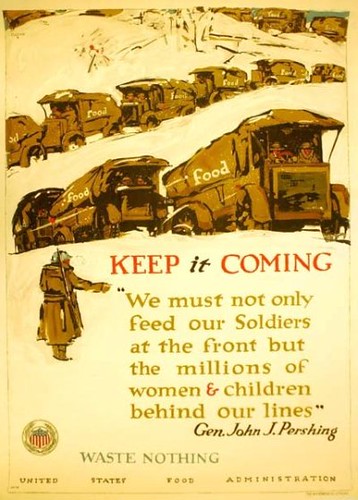As part of the ongoing exhibit of posters in Special Collections for Veterans Day, the students who created the exhibits also created entries for this blog. We will be posting these over the rest of the month of November.
1992.004.5.59 Keep it coming….Waste Nothing.
In the United States Food Administration poster by artist George Illiam, Keep it Coming: Waste Nothing, the Food Administration urges women to come to the aid of those behind the lines. According to TU Special Collections its date is somewhere between 1910 and 1920, however according to the Library of Congress, its date is closer to 1917: the end of the war. “Keep it Coming” would indicate that food has been arriving for some time, as is the presence of a quote from General John J. Pershing. Pershing says, “We must not only feed our Soldiers at the front but the millions of women and children behind our lines,” reminding women that they must think beyond their boys abroad and also to the other women and children in an unfathomable plight.
Illiam’s poster reminds women that the war is more than their boys; the war is truly world wide, encompassing all the women and children living in the war torn countries as well. This is a notable departure from other WWI posters in the University of Tulsa’s Special Collections. The majority of posters in Special Collections from the Food Administration fall into two categories; they either discourage wastefulness bluntly (Eat Less Bread), or they use moralistic language that reminds women of their boys abroad.
Keep it Coming: Waste Nothing reminds homemakers of the millions just like them and their children that are living in the midst of warfare. It is evident that women were the target audience of this poster by its emotional plea to traditionally “feminine” feelings such as love and empathy towards “helpless” women and children abroad. By rushing to their aid, women at home can save women like them abroad. Keep it Coming: Waste Nothing boosts morale by inciting their nurturing instincts to care for those broken families taking shelter behind the might of the great American Army. This is punctuated at the bottom with a stern command to, “Waste Nothing,” harkening back to pledges to do their part that most homemakers signed at the start of the war. By signing the Food Administration pledge, women were encouraged to “waste nothing,” and use as little fats, grain, meat, and sugar as possible in order to send it abroad to troops and families.
The artistic style and imagery of the poster supports both congratulatory effort previously made in self-rationing, but also encouraging further diligence in family rationing at the tail end of the war. The line of trucks navigating from the foreground to off in the distance indicates both the great need: that they need that and more to support the soldiers and the civilians, and also how much has been sent over so far. However the composition mainly consists of snow and ice, reminding American homemakers sitting in their warm houses of the dreadful conditions over there, and how desperately their food contributions are needed when the difference between life and death could be something as simple as a hot meal.
Keep it Coming: Waste Nothing has been included in books such as Art and the Great War by Albert Eugene Gallatin (pg 125), Wake Up America!: World War I and the American Poster (pg 245), and The Joseph M. Bruccoli Great War Collection At The University of South Carolina by Elizabeth A. Sudduth. Keep it Coming: Waste Nothing is a fairly widely circulated poster; copies exist at the Library of Congress, University of North Texas, University of South Carolina, and the Imperial War Museum, among others.
— Guest post by Jenny Fisher


